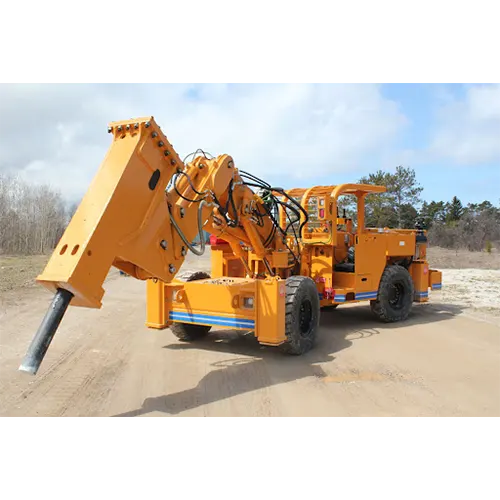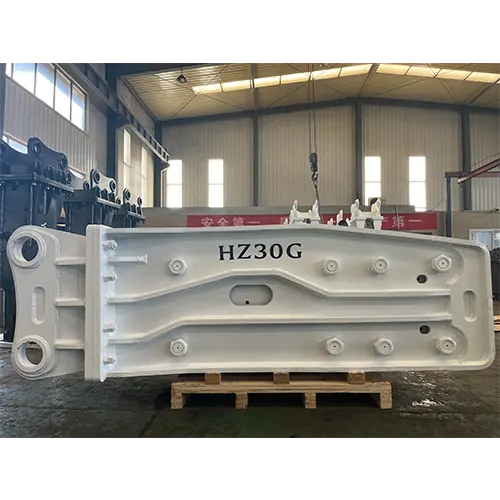Table of Contents
What is a rock breaker?

A rock breaker is a machine designed to manipulate large rocks, including reducing large rocks into smaller rocks. They are typically used in the mining industry to remove oversize rocks that are too large or too hard to be reduced in size by a crusher. Rockbreakers consist of two major components, a hydraulic hammer (used to break rocks) and a boom (the arm). There are two major types of rock breakers, mobile and stationary – typically placed on a pedestal or slew frame.
Is rockbreaker the same as hydraulic breaker?
A hydraulic breaker is a specific kind of rockbreaker. While a rock breaker is a general term for any equipment used to break rocks, a hydraulic breaker operates using hydraulic power, with a hydraulic system supplying high-pressure oil to drive a piston for rapid reciprocation and delivering a high-impact force to break hard substances. However, the concept of a rockbreaker is broader and can include other types like pneumatic or mechanical ones. Hydraulic breakers are commonly used in large-scale construction and mining, while rockbreakers in general can apply to a wider range of scenarios from major industrial projects to small-scale DIY tasks.
In which countries people think the rockbreaker is the same as hydraulic breaker?
In countries like the United States, Australia, and the United Kingdom, which have a significant presence in the construction and mining industries and where English is widely spoken, people often consider the rock breaker and hydraulic breaker to be the same. In these regions, due to the prevalence and common usage of hydraulic-powered equipment for breaking rocks in construction sites, quarries, and mining operations, the terms are used interchangeably. For instance, contractors, equipment operators, engineers, and workers in these industries typically refer to the hydraulic breaker as the main rock-breaking apparatus when discussing tasks such as demolishing concrete structures or breaking ore-bearing rocks, although technically a rock breaker could have a broader meaning encompassing non-hydraulic methods.
What are the big brands of rock breaker?

Some well-known brands of rockbreakers include Epiroc, Rammer, MONTABERT, Furukawa, and Atlas Copco. Epiroc is globally recognized for its innovative and high-performance rock-breaking solutions, serving diverse mining and construction needs. Rammer, associated with Sandvik Group, offers reliable and durable breakers used across numerous industries. MONTABERT, within the Komatsu Group, has a long history and holds various patents, contributing to its standing in the market. Furukawa is famous for its technological prowess and quality products in rock-breaking equipment. Atlas Copco, a major player, provides a wide range of efficient rock breakers that are highly regarded in the industry. These brands have established themselves through continuous research, development, and a commitment to meeting the demands of heavy-duty rock-breaking tasks.
Where is rock breaker used for?
Rockbreakers find extensive usage in multiple sectors. In the mining industry, they are crucial for fragmenting ore-bearing rocks in both open-pit and underground mines, facilitating the extraction and transportation of valuable minerals. In construction and demolition, they break hard ground for foundation laying and dismantle concrete structures like building columns and bridges. Quarrying operations also heavily rely on rock breakers to break large boulders into smaller pieces for further processing into construction aggregates. Their versatility makes them an indispensable tool in industries where dealing with hard rock formations is a common and necessary task.
How does a rock breaker work?
A rockbreaker operates mainly based on hydraulic power. Hydraulic oil, pumped by a pump usually driven by the host machinery’s power take-off, is conveyed to the breaker. Inside, a piston-cylinder mechanism exists. The high-pressure oil forces the piston to move forward rapidly, which is connected to a tool like a chisel.
Upon reaching the end of its stroke, the piston strikes the tool, transferring a powerful impact force to the rock, creating fractures. Then, the hydraulic system reverses the oil flow, retracting the piston, and the cycle repeats continuously. The rapid and repeated impacts, with adjustable energy settings in some models, break the rock into smaller fragments by dissipating mechanical energy and creating internal stress, facilitating the removal or further loosening of the rock pieces.
What are the major markets for rock breakers?
The major markets for rock breakers include countries like the United States, where construction and mining activities fuel demand; China, with its large-scale infrastructure and mining operations; Australia, due to its rich mineral resources and infrastructure projects; Brazil, given its growing mining and infrastructure sectors; India, as a result of booming infrastructure and expanding mining; South Africa, for its well-developed mining industry and infrastructure work; and Germany, with its strong construction and manufacturing sectors. These countries’ combined need for excavation, demolition, and mineral extraction in various industries creates a significant and continuous demand for rock breakers.
About Yantai Chongpo Rock Breaker

Yantai Chongpo is a professional manufacturer of hydraulic breaker located in Yantai China. Our factory has more than 20 years of experience in the industry. We are devoted to supply products to our customers with high quality, competitive price and best services. We hope our products will be a big support to your business. We are looking forward to the cooperation with you for a bright win-win future.

